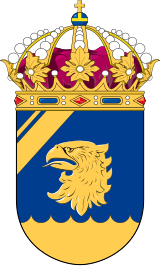Swedish Coast Guard
| Kustbevakningen (KBV) | |

|
|
| Agency overview | |
|---|---|
| Formed | 1988 |
| Preceding agency |
|
| Jurisdiction | Kingdom of Sweden |
| Headquarters | Karlskrona, Blekinge County |
| Employees | 800 |
| Minister responsible | |
| Agency executive |
|
| Parent agency | Ministry of Justice |
| Website | www.kustbevakningen.se |
| Footnotes | |
| SFS 2007:853 | |
|
|||||||
The Swedish Coast Guard (Swedish: Kustbevakningen) is a Swedish civilian government agency tasked with:
The Swedish Coast Guard carries out some of its surveillance by air (from its base at Skavsta Airport south-west of ), and in the winter-time by hovercraft on the ice-covered waters of the Bothnian Bay from its Luleå station. The Coast Guard also has regular maritime duties in Vänern, Europe's third largest lake, operating out of Vänersborg.
The Coast Guard has 26 coastal stations, including an aviation coastal station. The stations fall under four regional areas; North (KRN), East (KRO), West (KRV) and South (KRS); with the regional headquarters located in Härnösand, , Gothenburg, and Karlskrona respectively. Four management centers control the daily operational activities and there is also at least one duty officer around the clock. The Coast Guard's central headquarters is located in the historic 17th century naval city of Karlskrona, which is a UNESCO World Heritage Site.
The total number of Coast Guard employees across the country amounts to around 800.
Neither Coast Guard ships or officers carry military weapons. Instead each officer is equipped with Glock 17, ASP baton, OC spray and handcuffs.
The Coast Guard currently has 22 surveillance craft which are used mainly for patrolling with some also given oil spill response capacity.
The Coast Guard currently has 12 environmental protection vessels primarily used for oil spill response, and secondly for patrolling.
The Coast Guard currently has two ships which combine the characteristics of both environmental protection vessels and surveillance craft.
...
Wikipedia
